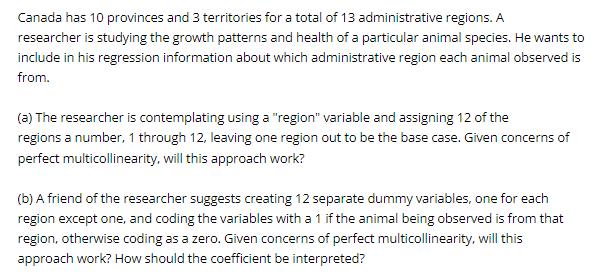Answered step by step
Verified Expert Solution
Question
1 Approved Answer
Canada has 10 provinces and 3 territories for a total of 13 administrative regions. A researcher is studying the growth patterns and health of

Canada has 10 provinces and 3 territories for a total of 13 administrative regions. A researcher is studying the growth patterns and health of a particular animal species. He wants to include in his regression information about which administrative region each animal observed is from. (a) The researcher is contemplating using a "region" variable and assigning 12 of the regions a number, 1 through 12, leaving one region out to be the base case. Given concerns of perfect multicollinearity, will this approach work? (b) A friend of the researcher suggests creating 12 separate dummy variables, one for each region except one, and coding the variables with a 1 if the animal being observed is from that region, otherwise coding as a zero. Given concerns of perfect multicollinearity, will this approach work? How should the coefficient be interpreted?
Step by Step Solution
★★★★★
3.39 Rating (155 Votes )
There are 3 Steps involved in it
Step: 1
a Using a region variable and assigning numerical values 1 through 12 to the 12 regions while leavin...
Get Instant Access to Expert-Tailored Solutions
See step-by-step solutions with expert insights and AI powered tools for academic success
Step: 2

Step: 3

Ace Your Homework with AI
Get the answers you need in no time with our AI-driven, step-by-step assistance
Get Started


